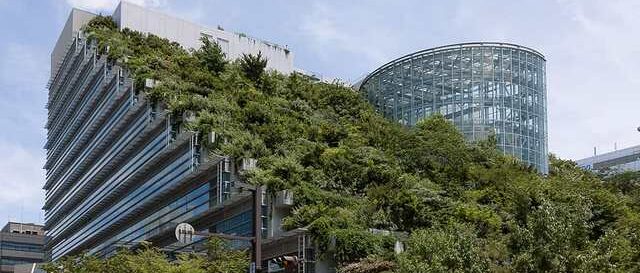Vertical farming is the practice of growing crops in vertically stacked layers. It often incorporates controlled-environment agriculture, which aims to optimize plant growth, and soilless farming techniques such as hydroponics, aquaponics, and aeroponics. Some common choices of structures to house vertical farming systems include buildings, shipping containers, tunnels, and abandoned mine shafts. As of 2020, there is the equivalent of about 30 ha (74 acres) of operational vertical farmland in the world.
The modern concept of vertical farming was proposed in 1999 by Dickson Despommier, professor of Public and Environmental Health at Columbia University. Despommier and his students came up with a design of a skyscraper farm that could feed 50,000 people. Although the design has not yet been built, it successfully popularized the idea of vertical farming. Current applications of vertical farmings coupled with other state-of-the-art technologies, such as specialized LED lights, have resulted in over 10 times the crop yield than would receive through traditional farming methods.
Is Vertical Farming Profitable?
The report states that very few vertical farming companies currently operate profitably. … Vertical farming uses carefully controlled growth conditions to give yields far higher than normal agriculture. However, labor and electricity costs form challenges. Apr 20, 2020








Commonly-grown crops in vertical farming ventures
As described on the preceding pages, certain crops have historically been associated with indoor farming. While it is theoretically possible to grow any plant completely indoors, economic factors typically limit the realistic set of crops to those that have a small growing habit (for maximizing the number of plants that can be grown in a limited space), are prolific producers (e.g. tomatoes on the vine), or can be grown and sold rapidly (such as microgreens). Compatible crops for vertical agriculture include the following:
| Summer squash | Herbs |
| Peppers | Lettuce |
| Eggplant | Spinach |
| Cantaloupe | Tomatoes |
| English Cucumbers | Strawberries |
| Microgreens & sprouts | Mushrooms |
According to VerticleFarming.com, a leader in vertical farming and studies they are doing, they wrote this article:
Producing farms
The following companies are currently producing at a commercial scale in the U.S. and Canada. All figures are estimated based on publically-available data and a composite estimate of wholesale market prices. Note that some recent entrants (VertiCrop in British Columbia and Vertical Harvest in Jackson Hole, Wyoming) are not yet included as they do not appear to have generated enough data to evaluate.
Table 1. Operating indoor/vertical farms – Estimated area, production, and sales
| Company | Locations | Total facility size (sq ft) | Estimated annual production (lbs) | Estimated annual sales* |
|---|---|---|---|---|
| AeroFarms | Newark, NJ | 105,500 | 3 million | $3.75 million |
| BrightFarms, Inc. | New York, NY | 366,000 | 3 million | $3.75 million |
| Farmbox Greens** | Seattle, WA | 600 | 27 k | $432k |
| farmed here | Chicago, IL | 90,000 | 1 million | $1.25 million |
| Garfield Produce | Chicago, IL | n/a | n/a | n/a |
| Gotham Greens | New York, NY | 170,000 | 2 million | $2.5 million |
| Green City Growers | Cleveland, OH | 45,000 | 1 million | $1.25 million |
| Green Sense | Portage, IN | n/a | 1.5 million | $1.875 million |
| Green Spirit Farms | New Buffalo, MI | 50,000 | 750 k | $0.9 million |
| Greener Roots | Nashville, TN | n/a | 30 k | <$50k |
| Local by Atta | Moncton, NB | n/a | 400 k | $0.5 million |
| Lufa Farms | Montreal, QC | 50,000 | 500 k | $0.63 million |
| The Plant | Chicago, IL | n/a | n/a | n/a |
| Sky Vegetables | New York, NY | 8,000 | 350 k | $438k |
| TruLeaf | Bible Hill, NS | 10,000 | 200 k | $250k |
| Urban Produce** | Irvine, CA | 5,500 | 150 k | $900k |
| Uriah’s Urban Farms | Tampa, FL | 24,000 | 500 k | $625k |
*Based on wholesale composite price of $1.25/lb for leafy greens. Retail operations see higher returns.
** microgreens at $1/oz n/a – not enough information to estimate
Below are videos from Verticle Farming in Urban areas. From rooftops to your own little backyard, anyone can do a healthy pesticide-free verticle garden.

